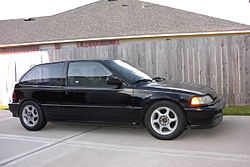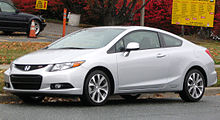- Honda Civic Si
-
Honda Civic Si 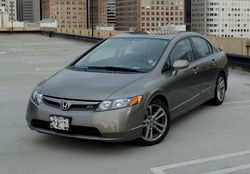
Manufacturer Honda Production 1984–present Class Sport compact Layout FF layout Related Honda Civic The Honda Civic Si is a sport compact / hot hatch version of the Civic built by the Japanese automaker Honda. The Si trim, which stands for "Sequential Injection" or "Sport Injected," was introduced for the third generation of Honda Civics in both Japan and North America. In Canada the trim became known as the SiR for the sixth and seventh generations, and the Si trim was equivalent to the USDM EX model.[1][2]
For the Japanese and European markets, the Civic Type R was adopted as the high-performance variant of the Civic, starting with the EK9 hatch for Japan in 1997 and with the EP3 hatch for Europe in 2001. In North America the Type R name has never been used for Civics, and the Si/SiR badge continues to signify the highest performance trim. The Civic Si contrasts with the more track-oriented and spartan Type R, which has less sound deadening and amenities in return for better performance, and has been positioned as more of a full-featured sport trim, featuring luxury options such as a sunroof and a seven speaker audio system.
Contents
1984–87
First generation Si
(AT)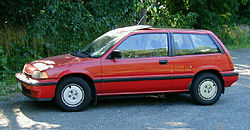
Production 1984–87 Assembly Suzuka, Japan
Alliston, Ontario, CanadaBody style 3-door hatchback Engine 1.5 L 91 hp (68 kW) EW3/4 I4 Wheelbase 94 in (2.39 m) Length 150 in (3.81 m) Width 64 in (1.62 m) Height 53 in (1.35 m) Curb weight 2,161 lb (980 kg) Honda first adopted the Si badge for the JDM third-generation Civic in November 1984. Mainly offered in hatchback form, the main aesthetic difference for the Si was the slight bulge in the hood, which accommodated for the DOHC engine. A four-door sedan variant also existed in Japan, but were produced in small numbers and were rare. Designated as ZC1 in Japan and D16A1 in Europe, the new engine put out 122 hp (91 kW), enabling the car to hit 122 mph (196 km/h) and go from 0–60 mph in 8.9 seconds.[3] Since compact cars at the time typically made less than 100 hp (70 kW), the Si proved popular amongst tuning enthusiasts.
In the United States, a Civic S trim was introduced in 1984, featuring sports seats and reclining rear seats. Although the S retained the semi-independent rear beam with coil springs for the suspension, a rear stabilizer bar was added to improve handling. Unlike the JDM Civic Si, the S trim used the same carbureted 1.5 L EW1 engine as the base and the DX trims. 1985 finally saw the US release of the Si trim with the Civic CRX Si, which featured a fuel-injected, 1.5 L SOHC EW3 engine making 91 horsepower (68 kW), a two-tone paint scheme; (blue, black or red) over gray-silver, 13-inch alloy wheels with 175/70R13 Michelin MXL tires, a standard power sunroof and sport seats. The comparatively quicker inline-four engine propelled the CRX Si from 0–60 mph in under 9 seconds.[4]
In 1986, the Si trim was extended to the Civic hatchback, offering the same performance of the CRX Si but with four-seats. Added improvements for the Civic Si hatchback included a removable glass sunroof, a five-speed manual gearbox, tilt steering wheel, a full-width taillight panel, a color-keyed front airdam and a roof spoiler. Like the CRX Si, the Si hatchback was powered by the same 91 hp (68 kW), 12-valve SOHC engine designated EW4/D15A3 (the latter code was used for the 1987 model year but with the same specs). The Civic Si also saw a release in New Zealand and Australia in 1987, and sharing similar specs to the American-market Si.
1989–91
Second generation Si
(EC/ED/EE/EF)Production 1988–91 Assembly Swindon, England
Suzuka, Japan
East Liberty, Ohio
Alliston, Ontario, CanadaBody style 3-door hatchback Engine 1.6 L 110 hp (82 kW) I4
1.6 L 158 hp (118 kW) I4Transmission 5-speed manual Wheelbase 98.4 in (250 cm) Length 156.1 in (396 cm) Width 65.6 in (167 cm) Height 52.4 in (133 cm) Curb weight 2,291 lb (1,039 kg) The second generation Civic Si shared a chassis with the 2nd generation Honda CRX. The American-market Si sported a 108 hp (81 kW) D16A6 engine and weighed in at 2,286 lb (1,037 kg), achieving a factory 0–60 mph of 8.1 seconds; and a quarter-mile time of 16.2 at 82 mph (132 km/h).[5] The main standard features of the Si trim were the power sun roof/moon roof, tachometer, passenger door mirror, color matched bumpers, dash clock, larger exhaust, front and rear anti-roll bars, 14" wheels and 4 lug and sport seats. Additional options were air conditioning and fog lights, as well as the different Honda Genuine Accessory alloy wheels.[6] In Europe and Australia, a more powerful D16A8 and D16A9 engines were used instead, which made 122 hp (91 kW) and 132 hp (98 kW) respectively.
Compared to the previous generation, the Civic Si saw an improvement in handling, in part due to the double-wishbone suspension at all four corners and lower wind drag due to the sleeker body shape.
Initially, the Civic Si hatchback was absent from the line-up, with only the CRX Si offered for the 1988 model year. That changed, however, for 1989, and the Civic Si hatchback was reintroduced, along with a 3-hp upgrade for the D16A6 engine across all Si trims (making 112 hp or 84 kW). As with all other trims, the Civic Si received a slight visual upgrade in 1990, featuring revised bumpers and tail lights.
In the later years of the second generation, the JDM version adopted a 1.6 L B16A engine that produced 158 hp (118 kW), and was the first to adopt the name "SiR" instead of Si. With its light weight, independent suspension and powerful engine, the car was well-received globally, receiving “Golden Steering Wheel Award” from the German newspaper Bild am Sonntag, and ranking first in France’s L’Automobile Magazine 1989 survey on car quality and reliability.[7] The European model badged as a "1.6i-VT" used a slightly less powerful B16A1 engine, which had an 8200 rpm redline and made 150 hp (112 kW), although it made the same 111 ft·lbf (150 N·m) of torque as the Japanese market B16.
Along with the introduction of the B-series, the second-generation Si saw the introduction of Honda's variable valve timing and electronic lift control technology, or VTEC. By providing two different camshaft profiles—one for fuel economy, one for performance—the VTEC engines set a high-revving, naturally aspirated precedent for future performance variants of the Honda Civic.[8]
Due to the difference in engine output and modification potential between the American and JDM models, the second-generation Si sparked a popular trend of engine swapping, where tuners would replace the D-series power plant (whose limiting factor for power were its weak connecting rods) with the stronger B-series motor.[9]
1992–95
Third generation Si
(EG6)
Production 1992–95 Assembly Swindon, England
Suzuka, Japan
East Liberty, Ohio
Alliston, Ontario, CanadaBody style 3-door hatchback (EG2/3), 4-door Sedan (EH9) Engine 1.6 D16Z6 125 hp (93 kW) I4,
1.6 D16A9 DOHC non-VTEC 137 hp (102 kW)Transmission 5-speed manual Wheelbase 101.3 in (257 cm) Length 160.2 in (407 cm) Width 67 in (173 cm) Height 50.7 in (129 cm) Curb weight 2,326 lb (1,055 kg) From 1992 to 1995, the USDM Civic Si used a 125 hp (93 kW) / 106tq single-overhead cam D16Z6 VTEC engine, which enabled the car to hit 0–60 in 7.5 seconds and a quarter-mile time of 16.3 at 86 mph.[10] VTEC activated on the intake side and not the exhaust side, which was the result of the spark plug blocking the area where the cam follower would be. Standard equipment included 14-inch steel wheels with plastic wheel covers, front and rear disk brakes, tachometer, dash clock, power sliding moonroof, cruise control, power mirrors, power steering, and driver's side airbag (the first Si to come standard with one). In 1994, a passenger side airbag and rear speakers were added.
Again, different regions adopted different power plants—the Japanese, European and Peruvian Si's used a 130 hp (97 kW) D16A9 engine. At this time, however, the Si was not the most powerful variant of the Civic in Europe; Honda introduced to the region the Civic VTi, which featured a 160 hp (119 kW) B16A2 engine. The JDM version SiR carried an even more powerful B16A engine, which made 168 hp (125 kW). Civics in Japan using the SiR name included the EG6 SiR-II (hatch) and EG9 Ferio SiR (sedan) Civics as well as the CR-X Del Sol.
In contrast to subsequent Si generations, the 92-95 used the same powerplant in the EX as in the Si (although automatic was available on the EX). Some of the Si models for the 1994 model year came with ABS brakes. The VIN# will have the imbedded sequence "EH339" as opposed to the regular Si designation of "EH338" in the number. Compared to the previous generation, the cowl was raised, which allowed for more suspension travel. Along with that change, the ride became softer than the previous generation, which provided a more compliant ride at expense of crisper handling.
1999–2000
Fourth generation Si
(EM1)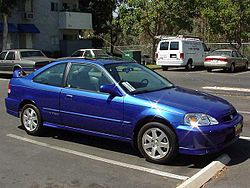
Production 1999–2000 Assembly East Liberty, Ohio
Alliston, Ontario, CanadaBody style 2-door coupe Engine 1.6L 160 hp (119 kW) I4 Transmission 5-speed manual Wheelbase 103.2 in (262.1 cm) Length 175.1 in (444.8 cm) Width 67.1 in (170 cm) Height 54.1 in (137 cm) Curb weight 2,606 lb (1,182 kg) After a brief hiatus in the Civic's 6th generation, the Civic Si reappeared in 1999. With the adoption of the VTi badge in Europe and the SiR and Type R badges in Japan for the sports variants of Civics, the Si became primarily a USDM-specific badge, a branding trend that would continue in subsequent Civic generations. Going from 0-60 in 7.2 seconds, the 1999 Civic Si trim featured a 1.6-litre B16A2 engine that made 160 hp (120 kW) at 8,000 RPM and 111 ft-lbs of torque at 7,000 RPM. Sharing a similar power plant to the 1.6-litre Del Sol VTEC, the Civic Si saw some notable differences, which include a larger throttle body, improved intake manifold, strengthened connecting rods, low-friction/high-silicon pistons, a fully counterweighted crankshaft, and an exhaust system with larger piping diameter. Due to its good fuel economy (27/31 city/hwy MPG), independent suspension at all four corners, and a more popular coupe form, the trim garnered a dedicated following in spite of its short production cycle.[11]
Changes from the standard Civic included stiffer, progressive-rate springs, stiffer front and rear anti-roll bars, and a tower brace, which contributed to a flatter-cornering ride. Aesthetic exterior changes from LX/EX models were minimal, with the Si trim featuring a lower-profile and wider 15-inch wheel/tire package, a subtle chin-spoiler, side sills, and Si badging. For the interior, the sixth generation Si had tilt adjustment for the bottom cushion, a standard CD player, sunroof, power windows and door locks, a leather-wrapped steering wheel, remote keyless entry, air conditioning, cruise control, and red-faced instrumentation with Si branding.
Like other Civics, this was the last generation of the Si to feature a front double-wishbone suspension. Subsequent Civics including the Si trims have since adopted the less-expensive and more compact MacPherson struts.
2002–05
Fifth generation Si
(EP3)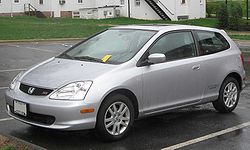
Production 2002–05 Assembly Swindon, England Body style 3-door hatchback (EP) Layout FF layout Engine 2.0L 160 hp (119 kW) I4 Transmission 5-speed close-ratio manual Wheelbase 101.2 in (256 cm) Length 165.7 in (420.6 cm) Width 66.7 in (167 cm) Height 56.7 in (142 cm) Curb weight 2,740 lb (1,240 kg) In 2002, the Civic Si received a complete redesign and returned to form as a hatchback. The body shape of this model was based on the "New Bullet-Form" concept, which aimed to create a more dynamic look and provide greater stability while traveling on highways or winding country roads. The interior layout also distinguished itself from other Civic Si generations with a dash-mounted shifter. Unlike other iterations of the Civic Si, the fifth generation was not produced in Canada or the United States, and it does not share a body style or interior with the USDM Civic (offered only in sedan and coupé forms) sold there. Instead, the 2002-05 Civic Si is manufactured in Swindon, England, and exported to Canada and the United States.[12][13] The EP hatchback is also used for the second generation Civic Type R which was sold in Europe and Japan.
Shifting away from the B-series engine, the seventh generation Civic Si adopted the K-series K20A3 engine rated 160 bhp (120 kW) at 6500 rpm and 132 ft·lbf (179 N·m) at 5000 rpm.[14] With a redline of 6,800 rpm, the Si distanced itself from the narrow, high-rpm powerband engine of its predecessor, and as a result saw a 20 percent increase in torque. Performance was relatively underwhelming compared to the competition; the switch to MacPherson struts from double-wishbone suspension resulted in less responsive handling, and a near-150 lb (68 kg) increase in weight to 2,744 lb (1,245 kg) contributed to slower acceleration than the lighter '99-'00 Si.[15] Much of the weight gain is attributed to the chassis' stouter structure when compared to the previous generation hatchback, with the '02 Si boasting an increase in torsional rigidity by 95 percent and a bending rigidity increase of 22 percent.[16]
With the increased chassis rigidity compensating for weight gain, the 5th-generation Civic Si saw roughly the same performance numbers as the previous generation Si, with 7.6 seconds to 60 mph and 14.5 seconds at the quarter mile.[17] Other factors adversely impacting performance included the lack of an LSD (limited slip differential) and having to shift into third gear to get to 60. First gear ends at about 30, second ends at 55, and third ends at 82 mph (132 km/h).
The 2004–05 models received minor revisions.[18] Cosmetic changes included revised headlight (dual bulb setup) and taillight designs, standard side skirts, and an option for a HFP. The suspension was updated with a change from 4 lug to 5 lug bolt pattern, a larger rear sway bar, and a change from 15-inch wheels (195/60-15) to 16-inch wheels (205/55-16). The interior received more silver accents in place of the chrome ones (the lock switch).[19]
The Honda chassis code for the Si and Type-S models is EP3. In Canada it was referred to as the Honda Civic SiR, and was discontinued in 2005.[1]
2003 Honda Civic Si Concept (2002)
For the 2002 SEMA show, Honda unveiled the 2003 Civic Si Concept, which showcased the aftermarket versatility of the Si.
Powertrain/chassis modifications included a GReddy T518Z turbocharger with an integral wastgate, a prototype GReddy front-mounted intercooler kit with aluminum piping, a GReddy Airinx high-flow intake system, a GReddy e-manage engine control manager, a GReddy Profec E-01 electronic boost controller (with e-manage programmer), widened track, Factory Performance sport suspension, a center mounted high-flow exhaust system, and a four-piston Brembo brake system.
The exterior saw changes including a Rally-inspired body kit, 18-inch polished titanium-finish wheels, a carbon fiber grill, front intake and rear bumper diffuser, a black chrome-finish headlights and smoked taillights, high-mounted two-stage rear wing. For the interior, Honda included Mugen carbon fiber and Kevlar race seats covered in red Alcantera suede with 6-point racing harness, a sport 3-spoke steering wheel, aluminum pedals and shift knob, Mugen high performance LCD screen gauge package, center mounted information display.[20]
2006–2011
Eighth generation Si
(FA5/FG2)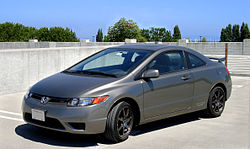
Production 2006–2011 Assembly Alliston, Ontario, Canada
Sumaré, São Paulo, Brazil (from January 2008–present)Body style 2-door coupe (FG2)
4-door sedan (FA5)Engine 2.0L 197 hp (147 kW; 200 PS) I4
2.0L192 hp (143 kW; 195 PS) in BrazilTransmission 6-speed manual Wheelbase 104.3 in (264 cm) (coupe)
106.3 in (270 cm) (sedan)Length 174.8 in (441 cm) (2006–08 coupe)
175.5 in (4,458 mm) (2009–11 coupe)
176.7 in (447 cm) (sedan)
177.3 in (4,503 mm) (2009–11 sedan)Width 68.9 in (172 cm) (coupe)
69.0 in (175 cm) (sedan)Height 53.5 in (134 cm) (2006-08 coupe)
56.5 in (142 cm) (sedan)Curb weight 2,877 lb (1,305 kg) (2006 coupe)
2,886 lb (1,309 kg) (2007-08 coupe)
2,899 lb (1,315 kg) (2009 coupe)
2,895 lb (1,313 kg) (2010-11 coupe)
2,945 lb (1,336 kg) (2007-08 sedan)
2,954 lb (1,340 kg) (2009-11 sedan)The Si was redesigned for the 2006 model year along with all other Civic trims, bringing about significant changes from the previous generation. The car comes with a 2.0-liter K20Z3 i-VTEC engine that produces 197 hp (147 kW; 200 PS) and 139 lbf·ft (188 N·m) of torque, while also including a 6-speed manual transmission with a helical limited slip differential. Forty percent stiffer spring and dampening rates from the non-Si trims and stiffer sway bars have bolstered the Civic Si's handling,[21] with the car achieving 0.90g (8.8 m/s2) of lateral acceleration on the skidpad. It is also the quickest Civic Si off the line, with a factory 0–60 time of 6.7 seconds according to Honda, but with some tests posting times as quick as 6.3 seconds.[22] Standard features include a moonroof, a seven-speaker 350-watt sound system, 17-inch alloy wheels with 215/45R17 Michelin all-season tires, and key-less trunk access.
In Canada, the Acura CSX Type-S was offered in 2007, borrowing the engine and drivetrain from the Civic Si but offering additional luxury options such as leather seating. The CSX features similar front and rear fascias to the JDM Civic, but with slight differences—the CSX has a crease running along the center of the hood and front bumper, whereas the JDM does not.[23]
The 2007 model changes for the Civic Si include the addition of the Si trim for sedans, vehicle stability assist (VSA) (not available on Canadian models. The 2010 and 2011 Canadian models had VSA), darker silver wheels, body-color grille, a deck lid spoiler, reversed red/black coloring on the secondary gauge cluster, and Si-embroidered front floor mats. The introductory price of the Si Coupe increased by $800 to the MSRP of $21,090.
For the 2008 model year, the Civic Si received minor tweaks that include even darker wheels than the 2007 model and a new shift boot with red stitching. Mechanical changes included a new tire pressure monitor system, a new rear upper arm that decreases the amount of rear camber, and a lowered spring rate for the coupe to match the sedan. This was also the first year Canada sold the Civic Si Sedan.
Vehicle color selections:
- Fiji Blue Pearl (Si-exclusive color, replaced by Dyno Blue Pearl in 09)
- Galaxy Grey Metallic (replaced by Polished Metal Metallic in 09)
- Habanero Red Pearl (Si-exclusive color, replaced by Redline Orange Pearl in 09)
- Nighthawk Black pearl (replaced by Crystal Black Pearl in 09)
- Rallye Red
- Taffeta White
- Alabaster Silver Metallic
Civic Si Sedan
Honda introduced the Civic Si Sedan for North America in 2007; previously, only the Japanese market had been offered Si Sedans.[24] Debuted at the Chicago Auto Show, the Si sedan concept featured larger 18-inch alloy wheels than its coupe counterpart, along with 4-piston Brembo brakes, and large cross drilled brake rotors. The production version lacked such concept accouterments, and the Si Sedan is mechanically almost identical to the coupe. Performance of the Si sedan is roughly equivalent to the Si coupe; the sedan's 60-pound (27 kg) weight increase is offset by a slightly more balanced front/rear weight distribution (60/40 for the sedan versus 61/39 for the coupe).[25]
Civic Mugen Si Sedan
The 2008 model year also brought into production the limited-edition 2008 Civic Mugen Si Sedan, which was announced at the 2007 SEMA auto show.[26] The Mugen sedan came only in Fiji Blue Pearl, and featured a higher-flowing cat-back exhaust, track-tested sport suspension, an exclusive Mugen grill, an exclusive shift knob, Mugen Si badges on the exterior and interior, and a Mugen body kit custom designed for the American trim. Production was limited to only 1000 units, and the car carried an MSRP of $29,500.[27] Even with additional features.[28]
2009 refresh
Changes for the 2009 Si included a revised front bumper and grill, a new split five-spoke 17-inch wheel design, fog lamps and a USB MP3 player input as standard equipment, clear-lensed and amber bulbs for the front and rear turn signals, a clear instead of red third brake light in the rear spoiler, and chrome trunk trim for the sedan. Several new colors were also introduced, such as Redline Orange Pearl, Dyno Blue, Polished Metal Metallic, and Crystal Black Pearl, replacing the previously similar colors.
The 2010 Civic Si saw no significant changes, save for a black engine cover (instead of silver).
2012
Nineth generation Si 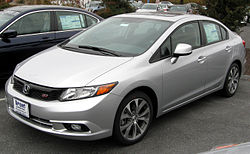
Production 2011-present Model years 2012- Assembly Alliston, Ontario, Canada Body style 4-door sedan
2-door coupeEngine 2.4L 201 hp (150 kW; 204 PS) Transmission 6-speed manual with Helical Limited-Slip Differential Wheelbase Coupe: 103.1 in (2,619 mm)
Sedan: 103.1 in (2,619 mm)Length Coupe: 176.1 in (4,473 mm)
Sedan: 177.3 in (4,503 mm)Width 69.0 in (1,753 mm) Height Coupe: 55.0 in (1,397 mm)
Sedan: 56.5 in (1,435 mm)The 9th generation Civic Si comes in a Coupe and a Sedan. The most notable difference from the previous generation is the engine upgrade. The Civic Si now features a K24 2.4L 201 hp engine (similar to the one found in the Acura TSX) capable of producing 170 lb·ft (230 N·m) of torque. The peak torque can be achieved at a much lower rpm as well, 4400 rpm vs the previous 6000 rpm. Retained is the 6 speed manual transmission with a slightly different final drive ratio. An automatic transmission is still not available. The wing spoiler found on the previous generation is replaced by a slightly more subtle deck-lid spoiler. The interior of the car gets a slight refresh as well, in the form of a rev limit indicator and a power meter, displayed in the all-new i-MID (intelligent Multi-Information Display). While the sway bars are noticeably slimmer than the previous generation's (18.0/15.0, down from 28.0/17.0 (F/R in mm)), the chassis is more rigid, the result of an increased amount of high-strength steel. Still included is the Helical LSD (Limited Slip Differential) found on the previous model.[29]
Media coverage
In Insurance Bureau of Canada's report on top 10 most stolen vehicles in 2005, 2000 Honda Civic Si 2-door, 1999 Honda Civic Si coupe, 1994 Honda Civic Si 2-door Hatchback, 1995 Honda Civic Si 2-door Hatchback are listed as ranks #1, #2, #5, #8 respectively.[30]
References
- ^ a b "Honda » Test Drive: 2004 Honda Civic Si Sedan". CanadianDriver. 2004-04-30. http://www.canadiandriver.com/2004/04/30/test-drive-2004-honda-civic-si-sedan.htm. Retrieved 2011-02-02.
- ^ "Honda Civic SiR". Canadianautoreview.com. 2002-04-03. http://www.canadianautoreview.com/honda_civic_sir.htm. Retrieved 2010-12-19.
- ^ "Honda Civic History". http://www.channel4.com/4car/ft/feature/retrospective/1691/5.
- ^ "Honda Civic Generations". Edmunds.com. http://www.edmunds.com/insideline/do/Features/articleId=68272.
- ^ "Honda Civic 0–60 and 1/4 mile times". http://www.albeedigital.com/supercoupe/articles/0-60_Quarter_Mile_Times/G_H_I_0-60times.html.
- ^ "Honda Civic 4th Generation". Civic4g.com. http://www.civic4g.com/.
- ^ "Fourth Generation Honda". honda.com. http://world.honda.com/CIVIC/generation04/.
- ^ "Honda Civic History". channel4.com. http://www.channel4.com/4car/ft/feature/retrospective/1691/6.
- ^ "History of the Civic Si". http://cars.ign.com/articles/688/688078p1.html.
- ^ "Honda Civic Si". Car & Driver. http://s260.photobucket.com/albums/ii27/LittleReezy/?action=view¤t=HondaCivicSi_CarandDriver_Feb92.jpg.
- ^ "New Car/Review 1999 Honda Civic Si Coupe". The Auto Channel. http://www.theautochannel.com/vehicles/new/reviews/1999/russ9932.html.
- ^ "Honda » Test Drive: 2004 Honda Civic Si Sedan". CanadianDriver. 2004-04-30. http://www.canadiandriver.com/2004/04/30/test-drive-2004-honda-civic-si-sedan.htm. Retrieved 2011-02-02.
- ^ "Honda » Test Drive: 2002 Honda Civic SiR". CanadianDriver. 2002-07-19. http://www.canadiandriver.com/2002/07/19/test-drive-2002-honda-civic-sir.htm. Retrieved 2011-02-02.
- ^ "2003 Honda Civic Si Specs". JB car pages. http://www.jbcarpages.com/honda/civic/2003/specs3/.
- ^ "2002 Sport Hatchbacks Comparison Test". Edmunds.com. http://www.edmunds.com/insideline/do/Drives/Comparos/articleId=57200/pageId=13487#12.
- ^ "2002 Honda Civic Si". Honda Worldwide. http://corporate.honda.com/press/article.aspx?id=200707061826.
- ^ Road & Track, July 2002
- ^ "2004 Honda Civic Review". JB car pages. http://www.jbcarpages.com/honda/civic/2004/.
- ^ "2004 Honda Civic Si Continues to Build on its Performance Heritage". Honda Worldwide. http://www.hondanews.com/search/release/1509?q=civic+si+2004&s=honda.
- ^ "2003 Honda and Acura SEMA Display Vehicles Fact Sheet". Automobiles.honda.com. 2002-11-05. http://automobiles.honda.com/news/press-releases-article.aspx?Category=Accord&Article=1205. Retrieved 2010-12-19.
- ^ "2006 Honda Civic Chassis". Honda. http://corporate.honda.com/press/article.aspx?id=2005083039848.
- ^ "Mid-Size Coupe Comparison". Motor Trend. http://www.motortrend.com/roadtests/coupe/112_0606_midsize_coupe_comparision/interior_performance.html.
- ^ "Auto Buzz". ReportOnBusiness.com. http://www.theglobeandmail.com/servlet/story/RTGAM.20061108.wh-buzz09/BNStory/Business/.
- ^ "Honda Civic Si Sedan Coming to Canada". CNW Group. http://www.newswire.ca/en/releases/archive/September2007/10/c7122.html.
- ^ "2007 Honda Civic Review". JB car pages. http://www.jbcarpages.com/honda/civic/2007/.
- ^ "Honda Announces Civic Mugen Si Sedan at SEMA". Honda. http://corporate.honda.com/press/article.aspx?id=3825.
- ^ "2008 Honda Civic Review". JB car pages. http://www.jbcarpages.com/honda/civic/2008/.
- ^ "Honda Civic Mugen Si Short Take Road Test". Car and Driver. http://www.caranddriver.com/reviews/hot_lists/high_performance/sport_compacts/2008_honda_civic_mugen_si_sedan_short_take_road_test.
- ^ "Error: no
|title=specified when using {{Cite web}}". http://automobiles.honda.com/tools/build-price/trims.aspx?ModelID=&ModelName=Civic%20Si%20Sedan&ModelYear=2012. Retrieved 13 October 2011. - ^ "Top 10 stolen cars". MSN Finance. http://finance.sympatico.msn.ca/insurance/insight/article.aspx?cp-documentid=1356163.
External links
- 2008 Honda Civic Si Coupe official U.S. site
TC 2000 Championship Seasons Current cars (2011) Chevrolet Cruze • Fiat Bravo • Honda Civic Si • Toyota Corolla • Renault Fluence • Volkswagen Golf • Volkswagen Polo • Ford Focus • Peugeot 307Current circuits Córdoba • General Roca • Oberá • Jorge Ángel Pena • Río Hondo • Resistencia • Santa Fe • Buenos Aires • Centenario • Punta del Este (Uruguay) • Eduardo Copello • San LuisFormer circuits Bahía Blanca • Comodoro Rivadavia • Güemes • Curitiba (Brazil) • Interlagos (Brazil) • Paraná • ViedmaCategories:- Honda Civic
- Sport compact cars
- Front wheel drive vehicles
- Front wheel drive sports cars
Wikimedia Foundation. 2010.

